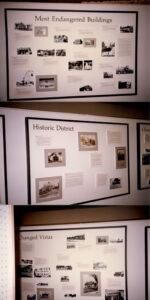One of our internal long term goals is to update our information on “Vanished Winchester,” one of our popular programs that originated with an exhibit held in the Kurtz Cultural Center in 1994. The display was initially open to the public October 1-November 11 and featured photographs of buildings either demolished or severely altered, with many of the photographs originating from the Stewart Bell Jr. Archives. Versions of this program have been hosted in the decades since and remain highly engaging.
Compiling demolished sites for the “Vanished Winchester” program dates back to at least early 1990. Stewart Bell, Jr. provided his list of significant buildings lost before the formation of PHW to us along with a handwritten note to Pat Zontine, PHW’s President at the time, and Anna Thomson, then Executive Director:
3-7-90
-Stewart Bell, Jr.
Dear Pat and Anna –
Here is my list of houses lost (mostly before the Conrad House controversy) that I personally remember. Each one I thought of as having some unique interest – either architectural or historical.
Of course it isn’t documented and should be used publicly.
I am pleased to share this list with you, because it supports my belief that my friends in P.H.W. should date this major victory (almost no significant buildings lost since Conrad House) from the Conrad controversy.
Maj. Whitehorne[?] observed in the Geo. Washington [history?] that most great military commanders had experienced significant defeat before achieving fame and success.
I think only Rose Hill, Willow Lawn, Miss Annie Reese’s house, and Mrs. Barton’s house are [lost?] since the Conrad House.
In the spring of 1994, John G. Lewis and Virginia Miller appear to have further expanded the initial list provided by Stewart Bell, Jr. It appears they used a combination of page by page marking photographs of demolished building in Images of the Past, combined with their knowledge of downtown Winchester from their work on the 1976 architectural survey. After two to three iterations of the list, 87 demolished or significantly altered buildings were identified, with nine additional sites posited to have possible documentation or to be marked for further investigation. About 60 photographs made it into the finished exhibit.
Unfortunately, only three of the exhibit panels seemed to have been photographed (“Most Endangered Buildings,” “Historic District,” and “Changed Vistas,”) and the text used for the image captions seems largely missing or to be very early draft copies. If you happen to have any more views of the exhibit or planning materials, we would be interested in obtaining more documents to flesh out the historic files.
We hope to make keep expanding our knowledge of some of these lost sites in a future series of blog posts. While we’re sure to cover some of the famous lost buildings like the Winchester Inn, the Cannonball House, and the Chanticleer Inn, we hope to also bring more recognition to other properties that have largely been forgotten or were lost too recently to have been covered in past programs. As the exhibit text stated in 1994, “We hope you find this exhibit both interesting and educational. We also hope that as you finish your [virtual] tour, you will agree that it is important that we all continue to work to safeguard our architectural heritage for future generations.”
Keep an eye out for the first featured building in a future post!

